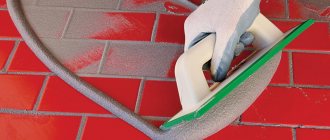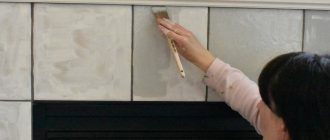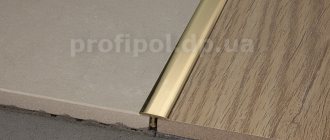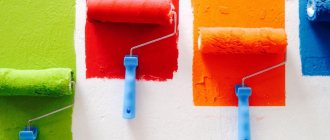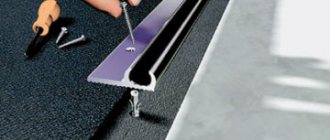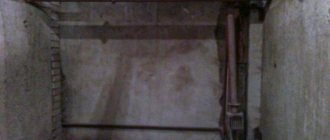Tiles are an excellent finishing material, which has a number of obvious advantages and an aesthetically pleasing appearance, which can easily be ruined by untreated, sloppy seams. It is for this reason that after laying ceramic tiles, the joints are putty, which hides all visible imperfections in a well-done job.
This procedure must be approached with absolute seriousness, since poorly carried out work not only does not eliminate the shortcomings, but will also add new ones, completely ruining the appearance of the finish.
For this purpose, a special grout is used, which fills all the resulting space between the tiles. Thanks to this, it acquires the most attractive and finished appearance. This article will discuss the distinctive feature of this technology. You will learn the details of how ceramic tile grouting is done.
Purpose of jointing
The jointing is done not only for the purpose of decoration, but also to avoid moisture from getting under the cladding.
The purpose of the jointing boils down to the following:
- Hygiene. Bacteria and various dirt do not accumulate in the joints between the tiles.
- Protection against moisture penetration. A special water-repellent composition is used for jointing. This prevents water particles from reaching the base of the cladding.
- The reliability of the product increases.
Jointing increases the working life of the surface being coated. In addition, it protects the tile adhesive from the destructive power of moisture. - Easy care. Grooving the joints between the tiles makes cleaning the surface easier. If you keep tile adhesive in the joint, it can fall out over time.
- Decorative qualities. Thanks to the jointing, the seams between the tiles look much more beautiful and neat.
Tile cleaning products
Edding 8200 is a colorful composition for touching up joint surfaces. It contains waterproof ink. It is produced in the form of a marker for more convenient application. You can find white and black markers with a line thickness of no more than 0.4 centimeters.
Pufas cement-ex is a product for removing cement mortar from tiles. Can be used on regular tiles, clinker and terrace tiles. The product is also used as a bath and sink cleaner.
Colored stain remover is used to clean tiles from stains of varying severity and nature of formation. Also suitable for washing natural stone, porcelain stoneware and all types of marble.
Pufas frische fuge. This is a colorful composition for easy renovation of seams. Not recommended for regular use. It is produced exclusively in white colors, but the addition of color is allowed.
Kiilto clean is an aggressive cleaning agent based on various acids. It is used to clean tiles from serious stains, so you should not use it every day.
Return to content
Peculiarities
It is important to understand that after completion of installation, at least 7 days must pass before it is possible to begin grouting the seams.
There are various types of glue that make it possible to start jointing already on the fifth day, but it is also preferable to wait.
Many tilers neglect this fact and, in order to complete the job faster, begin to grout the joints the very next day after laying.
This is impossible, since it can negatively affect not only the appearance of already finished seams, but also their quality and strength.
The peculiarity of flooring, compared to wall finishing, is the increased requirements for strength and density. For this reason, the grout for joints must be waterproof and stable to mechanical stress, and in addition have optimal elasticity.
The use of low-quality grouting material can cause the accumulation of debris and dust in the space between the tiles. And the penetration of moisture will promote the formation of fungus.
Nuances of choosing a shade
The universal rule for choosing the color of the grout is to match or slightly darker/lighter than the shade of the tile. Another universal option is to use a white fugue, which matches most shades of ceramic cladding, visually slightly expands the bathroom, and also hides minor unevenness in the edges of the tiles and errors made during its installation better than other shades.
For the floor, it is recommended to select dark shades to fill the joints: this will make accumulated dirt and dust less noticeable. White grout on the floor will turn gray in just a few months.
For finishes with a rich pattern or made of multi-colored tiles, a transparent aggregate or a special “chameleon” mixture, which has a different shade from different angles, is suitable.
Another interesting option is to add metallic powder of golden or silver color to the fugue, which makes the seams original and provocative. But it is worth remembering that this method of highlighting seams is suitable for certain design styles.
Advice! If you want to use a contrasting color to fill the seams, you should be guided not only by your taste, but also by the compatibility of shades so that the cladding does not look tacky.
A detailed article about how to choose grout is here.
Required Tools
To work you will need:
- Small rubber spatula. With its help, it is possible to carefully and uniformly fill the seams without various defects.
- Molding. A mechanism for forming a precise and neat line of joints between tiles. The molding can be replaced with a regular cable with the required cross-section or a toothbrush handle.
- A special knife with a cut blade designed for cleaning glue from joints.
- Construction syringe. Used for comfortable filling of joints with mortar.
- Foam sponge for cleaning the surface from fragments of the composition.
Materials
The final stage of finishing work is carried out with a grout mixture. Even in the case of seamless masonry, it will be required, because minor gaps always need protection from the penetration of moisture and dirt. Moreover, grout solves several main problems at once. Namely:
- preventing the appearance of fungi and mold;
- auxiliary strengthening of the outer coating in the cladding;
- ensuring dryness even during subsequent care;
- creating the desired decor for the cladding.
There are several types of grout. All of them, one way or another, have their own advantages and disadvantages. Therefore, their use is designed for a specific solution to problems.
Cement based
They are the simplest. Their use is not difficult, and they are sold ready-made. Application consists of pouring out a powdery substance and mixing it with water in special proportions.
You can find them on the back of the package.
Noteworthy is the fact that seams larger than 0.5 cm are not treated with such a mixture. Carry out the work carefully so as not to scratch the surface of the facing material.
The advantage will be the ability to choose from a wide range of colors and shades. But the disadvantage lies in the possibility of destruction from strong household chemicals.
Furanic
This grout is used in industrial facilities. The whole point is its complex application. The facing material must first be coated with ordinary wax.
Then, if it goes beyond the seam, the substance is removed using a hair dryer. Otherwise, it will dry out, and an aesthetically beautiful look cannot be achieved without replacement.
The main advantage will be the ability to use very caustic chemicals for cleaning. This ensures disinfection at all possible levels. The only downside is the black color of the grout.
Epoxy
Used in places of public use or sale of goods. It is easy to clean from dirt, as it is resistant to acid or strong alkali. The advantages include the presence of a solid substance in the chemical composition.
After drying, any dirt can be cleaned off quite easily. There is also a wide range of shades to choose from. The embodiment of the most daring ideas or design solutions is available to buyers.
Disadvantages include high cost and the inability to work in very small seams. The resulting consistency is very viscous. All work is carried out carefully.
Silicone based
Very easy to use. It is easy to learn, even for beginners, which makes it possible to use it in any household. The solution does not spread after squeezing out. All hard-to-reach places are processed without any difficulties.
Unfortunately, this is where all the advantages end. Among the disadvantages, instability to moisture is noted.
Moreover, this includes not only bathrooms, but also simple cleaning. If you neglect this property, you will have to fight fungi and mold.
Latex
One of the most convenient to use. The chemical composition is extremely elastic, which ensures 100% filling of each seam. Does not change its properties due to exposure to temperature or moisture.
It is even possible to cleanse with strong chemicals.
The advantages include a huge selection of shades and colors.
One of the disadvantages is the need to use antiseptics during jointing. These additional measures will once again protect against the appearance of fungi or mold. Also, during application, it is necessary to cover the edges of the facing material with masking tape.
Painting and whitewashing seams
The easiest and almost instant way to update tile seams is to tint them. This method has one significant drawback - the effect will last no more than six months, after which the grout will need to be renewed again. Also, most paint compositions cannot be used in humid environments.
Another non-radical way to improve seams is to apply a new grout material on top of the old one. This operation is only possible if the seams are deep enough. New grout will need about two millimeters of depth.
All necessary consumables can be purchased at any hardware or hardware store.
If you decide to use paint compounds, then it is important to know that they can be used not only to renew seams, but also to restore damaged areas. That is, the paint can be applied not only over the old grout, but also used as a grouting material, only this will require applying a larger layer.
The paint is quite easy to use. The first step is to thoroughly clean the area from possible contaminants, for example, plaque or mold. Then you need to carefully apply the paint to the tile joint and wait for it to dry.
Painting seams
If you catch a tile during the touch-up process, you need to remove the excess with a rag. The time required for the composition to dry is indicated on its packaging. There you can also find some recommendations for its use.
Return to content
Optimal seam width
It is necessary to decide on the selection of the width of the seam before the laying process. It depends on the preferences of the master or designer.
Here are a number of recommendations that can help you choose the best type:
- Seams wider than 12 millimeters will make the edges of the tiles visually smoother and hide their disadvantages. But you need to understand that this width reduces the reliability of the tiles, which leads to the formation of cracks. In order to avoid this, it is possible to add sand with large particles to the solution.
- A joint with a width of 3 millimeters is best suited for square tiles measuring 10 - 60 cm.
- It will be difficult to fill a 1.5 mm joint with grout. If the job is done poorly, moisture can seep between the tiles and ruin it.
There is no need to be afraid of making the seams wide, since narrow ones are much more difficult to work with and not any solution will be able to completely fill a small space.
Tips for choosing a composition
Knowing the purpose and main characteristics of various types of grout, it is quite easy to decide on the required composition:
- For relatively dry areas of the bathroom, where splashes only occasionally reach, a regular cement composition is suitable.
- To fill joints in wet areas, for example, in a shower, it is better to use waterproof mixtures: epoxy, polyurethane or cement with additives.
Also, when choosing the type of filler for joints, the type of base: stone wall or sheet cladding is taken into account in order to select a material with the required degree of elasticity.
In addition, when choosing a grout, you should pay attention to the structure of the tile itself:
- If the surface of the ceramic is glossy, you should not use coarse-grained grouts, but rather fill the seams with finely dispersed cement grout.
- The shiny "glass" joint created by using epoxy aggregates works well with mosaics and colored glass tiles.
- It is best to fill the joints between porous and relief tiles with coarse-grained cement or polyurethane fugue.
Choosing a color
Usually the shade of the grout is chosen to match the main color of the tile. It is possible to deviate by several tones, but designers do not recommend choosing shades that contrast with the main color.
However, if you choose the right palette, it is possible to use diametrically opposed combinations in order to achieve a fascinating and unique room design.
When selecting grout for floor tiles, it is better not to select white-colored solutions because of its impracticality. After a short period of time, the seams become a dirty gray shade. For snow-white tiles, designers usually advise choosing consistencies and pastes of light gray colors of different intensities.
Preparatory work
Before starting restoration work, you should get rid of everything that could interfere with its implementation. For example, you will need to remove wall cabinets and any other elements that block access to the tiles. It wouldn’t hurt to take out the furniture, thereby freeing up the floor.
If we are talking about the kitchen, then it is better to dismantle the gas or electric stove. In the bathroom, you will have to remove the plumbing equipment, and perhaps even take out the bathtub for a while.
Now you need to think about personal protective equipment, without which it is highly not recommended to work with adhesive materials, acidic cleaning compounds and cement solutions. All work must be carried out wearing glasses and gloves.
Necessary protective equipment
Return to content
Preparation of the solution
It is imperative to prepare the mixture in a clean and dry container (for example, a bucket), since if water or dust gets in, the grout may become unusable or lose quality.
To dilute the container, you need to pour water or another required mixture (will be noted in the instructions) in a ratio of approximately 3/4 of the container.
The dry mixture must be added gradually, thoroughly stirring the composition. Then the remaining water is poured into the mixture in small doses.
The resulting mass must be allowed to stand for approximately 10 minutes so that the dry lumps can become saturated with liquid. After the composition has infused, it should be thoroughly stirred one more time until a homogeneous mass is obtained.
IMPORTANT! It is necessary to regularly monitor the consistency of the solution, since in some cases less water may be required than specified in the instructions.
What needs to be done to prevent cracks from appearing
All possible causes of damage must be eliminated:
- mobility of the rough foundation (incorrectly executed cement screed or unstable wooden structure);
- violation of the proportions of the components;
- exposure to water before the solution hardens.
The work is carried out making sure that the base is strong. If there are defects, it must first be repaired, then cladding done. The grout mixture must be viscous, without separate fractions, and have a uniform structure. It is applied to clean, dry surfaces. Further work should be carried out when the fugue is dry.
Surface preparation
Before grouting, newly laid tiles should be left for about 7 days. But it is worth considering that different types of tile adhesive have different drying times. 7 days will allow literally all types of glue to dry.
Next, you should clean the excess from the seams using a soft metal float, knife or sandpaper.
Wipe with a sponge or vacuum cleaner to get rid of small particles. Without these steps, the tiles or grout may soon begin to crack.
Is it possible to grout tiles with tile adhesive?
This is a frequently asked question, especially since most often the glue remains, and the grout must be purchased separately. Most craftsmen agree that for rooms lined with ordinary tiles, it is best to use grout, since it performs protective and decorative functions and is available in a large palette of shades, while the glue is gray.
Filling the joints with tile adhesive may be justified in the case when facades or other surfaces exposed to weathering are used with porcelain tiles. In this case, if there is no reliable waterproof grout, the seams can be filled with glue, since the unreliable grout will fall out of the seams over time, and the tiles will move away from the base under the influence of moisture. In this case, it is better to grout the seams immediately during installation so that the adhesive layer is completely monolithic.
We recommend watching a video on this topic and drawing your own conclusions about the advisability of this method.
Application technology
There are different tools for application, but all you need is: a small container, metal and rubber spatulas, a bucket of water, a thick sponge and a piece of cable. Prepare the grout mixture according to the instructions on the package. Most often this is the ratio of 1 kilogram of dry mixture to 300 milliliters of water.
The main thing is not to add too much water as this will affect the properties of the material. Add the dry mixture little by little to the water while constantly stirring it. Let it sit for about 5 minutes and you can start grouting.
After making the mixture, use a rubber spatula to press the mixture into the seams, collect the excess and rub it in again.
Then we pull it perpendicular to the seam with a metal spatula and cut off the excess. And let's move on to the next section. After about 15-20 minutes, we begin to wash the seams.
At this stage, it is important to squeeze the sponge out well, as if it is very wet, so-called patches of different colors may appear.
Using a sponge, we remove the grout around the seam and if you chose the right time, the seam does not stretch behind the sponge, but it is still elastic. After this, we take a cable that fits the width of the seam and press it in, thanks to which we get indentations that are made using a professional spatula.
We wipe the squeezed out mixture with a sponge, then rinse everything again with a damp, but not wet, one, and after a day the seam may come into contact with water. And after 5-7 days, it will reach its final strength.
Subtleties of the process
The procedure for applying the grouting material is not particularly difficult if you use a cement-based mixture. The space between the tiles is filled with the mixture using a rubber spatula. The tool must be held at an angle of 30 degrees in relation to the ceramic tile. To apply epoxy resin grout, you need to use a construction syringe.
Don't miss: Leveling the ceiling with plaster and polystyrene foam chips
The grout should be pressed lightly to completely fill the gaps between the tiles. Excess grout must be removed using a spatula and redistributed over the seams. When the space between the tiles is completely filled with the mixture, you can begin finishing another area. Approximately five minutes after applying the grout, the seams should be treated with a special molding spatula or a piece of cable of a suitable size.
Such manipulations will allow you to remove excess grout mixture and form a beautiful seam. 20 minutes after grouting the joints, it is necessary to wash off the remaining mixture from the tiles. Otherwise, the putty will dry out completely and cleaning it will be problematic. You can wash the surface with a damp cloth or sponge.
How to seal the seams between the tiles, see the following video.
Grout update
The most common way to update grout is to use household chemicals. But it can be different, from powders to all different gels. If you are going to use a powder product, the most popular are: Comet, Bref, Pemolux and Domestos.
Of the listed products, only Comet and Bref should be considered for use.
Comet is worth using due to its disinfecting ability. And Bref because of its low price in Russia.
Gels are very expensive and are used only when nothing else helps.
The way to use them is to apply the gel to the seam and then leave it for 8-9 minutes. Then use a hard sponge and plenty of water to remove the gel and seam.
But no matter what product you choose, we advise you not to use sprays as they are most often the final remedy.
After choosing a product as a brush, you can use a toothbrush or any other brush with stiff bristles. Dilute the product you have chosen with water and dip the brush in it and carefully wipe the seams until they completely disappear.
After that, rinsing with water and bringing it to perfection with sandpaper, drying it and performing exactly the same actions as when applying a seam.
Mechanical methods
Mechanical methods are the best way to remove grout. Such methods are much more effective than traditional ones. They will certainly remove the putty from the surface itself, as well as remove it between the seams.
How to remove grout? Old putty between the tiles can be removed with a construction knife, joint spreader, electric drill, Dremel and screwdriver.
Absolutely all methods work well and clean seams perfectly. You don’t have to immediately run to the store to buy a tool, look at what you have in the house, one will be enough.
And if you can’t get the job done, or the tool seems inconvenient, then check out other methods and choose the most suitable one.
Construction knife
This method of removing old grout from tile joints is the safest.
Any mechanical procedures require maximum attention; try not to be distracted by conversations and other details.
How to remove:
- Insert a paint knife into the old grout between the tiles.
- Start moving the blade at an angle. That is, slowly move it from the bottom corner of one tile to the top corner of another. Repeat the same thing, only from the bottom second to the top first.
- The old putty will immediately begin to fall out. Pry up the remains and remove them from the joints with the same painting knife.
This tool is very sharp, so be extremely careful. Also carefully handle the surface cleaned from the edges of the fugue; you can easily knock off the corners.
Stipper
A suture opener is a tool that is designed specifically for this procedure. Removing old grout with its help is quick and easy, without damaging the tiles.
The seam spreader has a comfortable handle and a sharp blade. An alternative is a painter's knife or a kitchen knife.
How to remove old grout:
- Bring the stitcher to the seam and press the blade against the seam.
- Apply a little force to get the blade to bite into the puffer. Carefully go over the grout areas on both sides.
- Then pry up the putty and it will fall off on its own.
Be careful with corners. These places are considered the most vulnerable to chipping.
Electric drill
Cleaning can be easily done with a tool such as an electric drill. Removing the fugue between the joints of tiles in the bathroom or kitchen is not difficult if you have previously used a similar device.
How to remove grout from tile joints with a drill:
- Buy a thin drill and change it. The drill should be slightly smaller than the seam itself so as not to touch the tile, otherwise it will crumble.
- Mix vinegar and water in a 1:2 ratio and apply it over all joints. This mixture will loosen the putty a little. In half an hour you can start working.
- Set the device to medium speed. If this is your first time removing the puffer this way, turn on low speed.
- Hold the tool well so that it does not fall out while working.
- Remove the fugu carefully and take your time. Work an hour more than planned, but keep the tile intact.
- After you have cleaned the seam between the tiles, go over it with a brush, removing any remaining fugue or cement.
Then you need to wipe off the remaining putty from the tile itself. Use chemical reagents or traditional methods.
Once the surface is dry, apply a new grout between the joints of the bathroom tiles.
Dremel
The electric chisel resembles a smaller and simplified version of the grinder. It's easier to work with, which is why most people use it.
Principle of using the tool:
- Turn on the device.
- Work in a circle along the joints, trying not to touch the edges of the tiles.
- All that remains is to wipe off the remaining putty from the surface and brush off the dust.
This procedure should be carried out if you are confident in yourself. If your hands shake while removing the fugue, stop. The tile will become cracked or chipped if you accidentally touch the edges.
Screwdriver
If the grouting was done too early, or something got under the seams, a screwdriver will help remove the putty.
Don't miss: Entrance metal doors for apartments
This special tool is actually used for something else, but is also suitable for cleaning joints from hardened joints. Professionals in tile laying love to use this device.
How to remove grout from tile joints:
- Buy a thin circle with a brush at the store.
- Plug in the instrument.
- Place the circle on the joint, press the button and start stripping.
Be careful. The brushes rotate at such a speed that you can easily damage the tiles.

